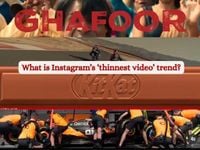Social media is once again in the throes of a creative transformation, as two distinct but equally captivating visual trends are sweeping across platforms like Instagram and TikTok. On September 25, 2025, users are finding themselves surrounded by a new wave of AI-generated polaroids and ultra-wide cinematic videos, each trend offering a fresh way to reimagine personal memories and brand narratives.
Let’s start with the AI polaroid phenomenon. According to The Tab, this trend involves people using artificial intelligence tools—most notably Google Gemini—to edit pictures of themselves so that they resemble polaroids snapped against a classic white curtain backdrop. While at first glance these images might seem like simple retro throwbacks, the twist is that many users are pictured hugging their younger selves, creating heartwarming, even surreal, digital family portraits.
It’s so convincing that some have admitted to being fooled. “I felt so boomer when I first saw this trend, because TWICE I thought it was real. How embarrassing,” wrote one observer in The Tab. The realism of these AI images has left people second-guessing what’s authentic and what’s fabricated, blurring the line between memory and imagination.
To join in, users simply upload two photos—often one current and one from childhood—and use a specific prompt with Google Gemini: “Make me a picture with a polaroid camera. The photo should look like a regular photo, with any clear subject or property. The photo should have a slight blur effect and a consistent light source, such as a flash from a dark room, scattered through the photo. Do not change the face of the people in the images. Replace background of the two photos with a white curtain. Hugging.” This formula gives the resulting image that nostalgic, slightly imperfect charm of a real polaroid, while the white curtain background adds a consistent, shareable aesthetic.
But as with all things AI, there are boundaries. Google Gemini’s safeguarding guidelines sometimes block the creation of images featuring younger versions of people, citing age verification issues and a policy against editing faces. This means that the trend isn’t always accessible, especially when the AI can’t confirm the ages in the photos. Additionally, users are cautioned to seek consent from anyone featured in these AI-edited images. “Do not add random people you don’t know—because that’s literally weird,” The Tab reminds readers. Even public figures, like pop stars, are off-limits unless permission is granted. The dangers of AI manipulation—misrepresentation, loss of control over one’s image, and potential misuse—are all summed up in this viral trend.
Meanwhile, over on Instagram, another visual revolution is underway. As reported by Zee Business, the ‘thinnest video’ trend is captivating creators and brands alike. This format features ultra-wide cinematic strips, with a resolution of 5120x1080 pixels. The process is simple but visually striking: creators crop the top and bottom off standard videos, leaving a slim, panoramic movie strip that slices across the screen. The effect is instantly eye-catching, giving even old or mundane footage a sleek, futuristic vibe.
Brands have been quick to jump on the bandwagon. Netflix India, KitKat, McLaren, BlinkIt, Kerala Tourism, Myntra, BMW Motorrad, Nothing India, Google India, Prime Video, Red Bull US, and even the Indian National Congress have all adopted the thinnest video format for marketing and messaging. The trend’s versatility is a major draw. Kerala Tourism, for instance, turned their lush landscapes into ultra-wide digital postcards, captioned: “God’s Own Country, framed to perfection.” Netflix India and KitKat leaned into humor and pop culture, while the Indian National Congress used the format for political messaging, posting a reel featuring Rahul Gandhi with the punchy caption, “Aa raha hai Hydrogen Bomb jald hi!”
For creators, the appeal lies in the ability to repurpose old travel vlogs, make product ads look like short films, or simply add a surreal, Ghibli-meets-Hollywood touch to everyday content. “It’s like giving your video a Ghibli-meets-Hollywood treatment without shooting something new,” Zee Business explains. Wide landscapes, cityscapes, and sports footage are especially well-suited to this ultra-wide look, but the format is flexible enough to work with just about any visual story.
What’s behind the success of these trends? Part of it is novelty—both formats break the visual monotony of the feed, whether it’s the soft, blurred nostalgia of an AI-generated polaroid or the cinematic sweep of a thinnest video. But there’s also a deeper current: a desire for personal storytelling that feels both intimate and elevated. Hugging one’s younger self in a digital polaroid taps into universal themes of memory and self-reflection, while the panoramic strips of the thinnest video trend evoke the grandeur of the movies, making everyday moments feel epic.
Of course, with every new trend comes a set of ethical questions and technical hurdles. The AI polaroid trend, for example, raises concerns about consent and the potential misuse of personal or celebrity images. Google Gemini’s safeguards are designed to prevent some of the more obvious pitfalls, but the responsibility ultimately falls on users to respect privacy and ownership. “It goes without saying that even public figures (like female pop stars) deserve to have ownership of where their face is used and if it’s a doctored image it’s all the dangers of AI summed up,” The Tab warns.
The thinnest video trend, on the other hand, is less fraught with ethical dilemmas but still requires a certain level of technical know-how to get the cropping just right. Pro tip: this format works best with cinematic shots—wide landscapes, cityscapes, or sports footage. The earlier you jump in, the better your chances of catching the algorithm’s wave, as Zee Business points out. And, as always, brands and political groups are quick to adapt, using the format to stand out in a crowded digital space.
For everyday users, these trends offer a chance to experiment and play. Whether you’re crafting a digital hug with your childhood self or slicing your vacation footage into a cinematic strip, the barriers to entry are lower than ever. Most tools are free or built into AI platforms, and the instructions are just a Google search away. The only real limits are your creativity—and, of course, a healthy respect for privacy and consent.
As social media continues to evolve at breakneck speed, trends like the AI polaroid and thinnest video serve as reminders of both the power and the pitfalls of digital creativity. They’re testaments to how technology can reshape the way we see ourselves and the world, one viral format at a time.




